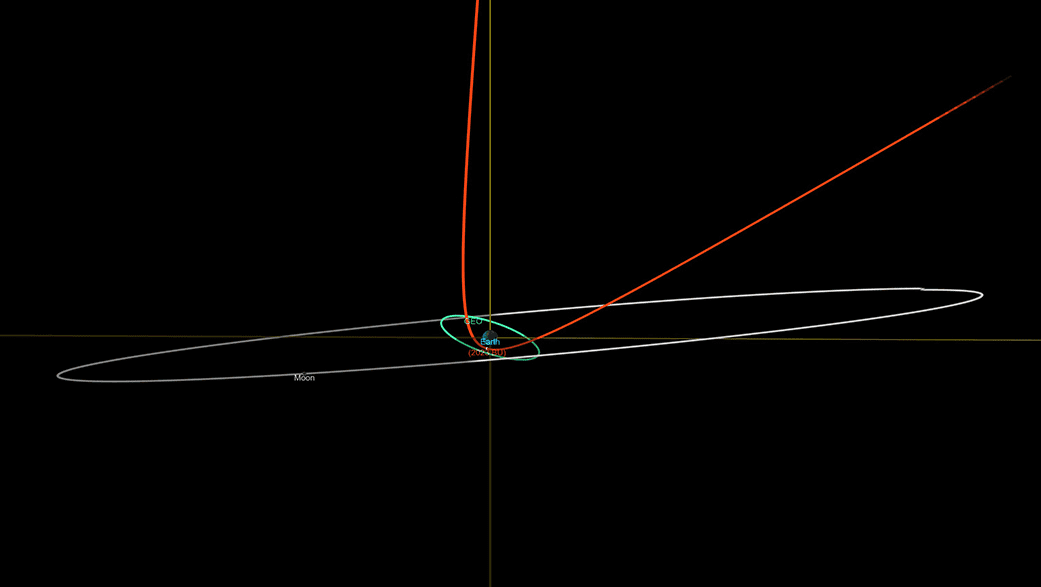Predictions of close asteroid approaches are becoming common as we gain more knowledge of objects with Earth-crossing orbits. Nevertheless, the passage of 2023 BU over South America shortly after midnight GMT tonight is on quite a different scale.
Many astronomers define a close approach as coming inside the orbit of the Moon, although more distant passages still attract attention if the object in question is large enough. Tonight 2023 BU’s will briefly be 100 times closer than that, causing it to leave on an entirely different orbit.
Nevertheless, 2023 BU won’t exactly be skimming the atmosphere, and indeed will be 3,000 kilometers (1,800 miles) further from the planet’s surface than the International Space Station or most other low-Earth orbit satellites. On the other hand, it will be ten times closer than satellites in geosynchronous orbit.
A collision with 2023 BU wouldn’t have been disastrous either, at least on a planetary scale. At somewhere between 3.5 and 8.5 meters across (11-28 feet), this is no dinosaur killer. An object that size hitting the atmosphere would create a dramatic explosion. Some pieces would probably make it to ground as meteorites, but the danger would be similar to the Long March 5B rocket boosters that have fallen recently. You wouldn’t want to be under one, but only those directly hit would be affected.
NASA calls 2023 BU “about the size of a box truck”, but on social media people have searched for other comparisons, from the now-familiar giraffes (at the lower end of estimates) to buses.
It’s encouraging an object this small was spotted five days before closest approach, in this case by Gennadiy Borisov, discoverer of the second known interstellar comet. Borisov could tell the object wasn’t large enough to be a serious danger, but there was initially some uncertainty as to whether it might hit or not. Follow-up observations were made by other observatories. As soon as the Minor Planet Center announced the discovery, amateur astronomers around the world joined in, refining the orbit sufficiently that NASA’s Scout impact assessment system could confirm there will be no impact.
“Scout quickly ruled out 2023 BU as an impactor, but despite the very few observations, it was nonetheless able to predict that the asteroid would make an extraordinarily close approach with Earth,” said the Jet Propulsion Laboratory’s Dr Davide Farnocchia in a statement. “In fact, this is one of the closest approaches by a known near-Earth object ever recorded.”

The path of 2023 BU compared to the Moon (grey) and geosynchronous satellites (green). The influence of the Earth’s gravity can be seen in the different incoming and outgoing lines. Image credit: NASA/JPL-Caltech
The earliness of the discovery adds to hopes that when a somewhat larger object is on a direct collision course we might get at least as much notice. Five days would certainly not be enough to send up a heavy impactor or nuclear weapon to deflect a threat, but if the incoming space rock was of a size to threaten a city rather than the whole planet, warnings like this could save lives.
When detected, 2023 BU was on a nearly circular 359-day orbit. Although similar to the Earth’s in shape and length, its plane is at a steep angle to our own. The encounter is expected to shift it into a quite elongated orbit lasting 425 days.
Because 2023 BU will pass above the southern tip of South America, few people will get a chance to witness it up close. Moreover, with passage occurring late on a summer evening, daylight will impede observations further.
It is, however, being broadcast live on The Virtual Telescope Project, allowing you to see it from wherever you are.
Source Link: One Of The Closest Asteroid Approaches Ever Predicted Will Occur Tonight